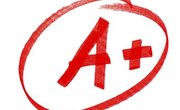Among the many confusing new things that you might hear in the first year of college is that your test scores will be graded on a curve. What does that mean? Grading on a curve is a method that college and high school teachers use to adjust the grades to make sure they have a normal distribution.
Grading on a curve has its advantages and drawbacks, so it is disputed in the academic community. It might mean that your letter grade is bumped unexpectedly upward, or it might mean that it's virtually impossible for you to get an A because you're being compared to other more successful students in the class.
Bell Curve Definition
In statistics, the bell curve is a symmetrical bell-shaped curve that represents the distribution of a set of data or values. The highest point in the middle of the curve represents the maximum probability. The bell curve establishes normal distribution, meaning that the data is distributed evenly across the sections of the curve.
Out of all the different methods of grading on a curve, the bell curve method is the most popular method. If you’re being graded on a curve that means that most of the students in your class will receive a grade that falls in the middle of the curve, which is somewhere between the highest score and lowest score, making it the average score out of the number of students.
To ensure normal distribution, the teacher will assign only a small percentage of students to receive the highest and lowest grades. For instance, five percent of the students will receive As and Fs, 12 percent of the students will receive Bs and Ds, and the rest, 66 percent, will receive Cs.
Reasons Teachers Use a Grading Curve
Teachers use a grading curve in order to analyze student performance on their tests. Many teachers consider the test adequate if the bell curve is visible with absolute scores.
For example, if the mean, or average grade of a test is C, and only a small percentage of students managed to get As and about the same percentage got Fs and slightly more got Bs and Ds, then the test was adequate. It was not too hard and not too easy and had a fair distribution of grades for the whole class.
If on the other hand, the absolute scores reveal that nobody got above 80, that might mean that the test was inadequately hard. In that case, the teacher might boost the student’s scores bringing them closer to the normal distribution, making sure that there are enough As and Bs to create a normal distribution closer to the top score, creating a new grade.
How Grading on a Curve Works
There are several ways teachers create a test curve. First, if no one in the class scored 100, the teacher might take the highest grade (like a 90) and bring it up by a certain number of points, for example 10. She then adds 10 points to all the scores. This then brings up the class average.
Another method is using a square root curve. In this method, the teacher takes the square root of the raw score for each student and multiplies it by 10. For example, the square root of 90 (rounded up to two decimal places) is 9.49. Multiplied by 10, the final score will be 94.9. With this method, lower scores will be bumped higher, but higher scores will not exceed 100.
Advantages and Disadvantages of a Curve
Grading on a curve has its advantages and drawbacks. The advantage of grading on a curve is that it prevents the teacher from accidentally using grade inflation and fixes those situations where the test was poorly designed. Also in most instances it tends to give poor performing students better grades. For example, if 50 percent of the students in the class get an A, this A might not mean much. On the other hand, if nobody got above a C, that just means that the test was too hard and not representative of the material taught. In that case, the grade curve might help remedy it.
On the other hand, if you’re graded on a curve, it might mean that no matter how hard you study, you will not get an A because there are a large number of star students in the class. If you score 95, it doesn’t mean you get an A because 10 percent of the class scored 100. This may cause some undeserved failing grades.
Large class size helps alleviate the disadvantage of grading on a curve because average students should be more plentiful due to the law of large numbers. Thus, a top student stands a better chance to outperform the average score on a midterm exam because of the large class size.
Outliers may also seek extra credit to ensure a higher grade. For example, if a student is top of the curve which means the median, mode, or average of the bell curve, scoring students on a grading curve will still find students scanning the course syllabus to chase extra credit as a means to boost their gpa. This happens from law school to high school.
Some teachers recommend that to avoid creating an environment where the entire class is pitted against one another, test curving should only be done to boost student grades and not deflate them as they can have a major effect on students final grades.
Final tip
Check the syllabus to see if your teacher grades on a curve
Related Articles
References
Writer Bio
Tanya Mozias Slavin is a former academic and language teacher. She writes articles about education and linguistic technology, and has published in the Washington Post, Fast Company, CBC and other places. Find her at www.tanyamoziasslavin.com









